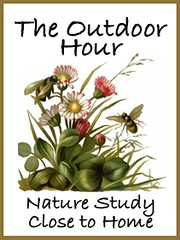Here's the next section of the reading in HONS, pp 35 - 47:
1. Describe something you learned about Migration by reading this
section.
I loved reading about the Artic tern, who nests in the Artic and winters in the Antartic, making a round trip of 22,000 miles each year and has more hours of daylight than any other animal on the globe! Migrants are either summer residents in our area or winter residents, or 'visitors' if just passing through. Some species have a different migration route south than the return one north.
2. Do you have any unusual birds who migrate through your area?
Describe.
I'm not aware of any yet.
3. How does a bird’s eye sight compare to a human’s?
All birds have much better eyesight than humans. Birds such as hens cannot see the same object with both eyes at the same time, which is why they often turn their head to look at us with their other eye. However, she can see all around her all the time.
4. Does a bird have a distinguishable ear?
Birds' ears are usually just a hole in the side of the head, covered with feathers.
5. Compare and contrast the hen’s beak and its uses with the duck’s bill
and its uses.
A hen's beak is sharp and pointed so that she can use it like a pick on the soil and like a pair of nippers. The duck's bill, on the other hand, is broad and flat and much softer. It's used like a sieve to strain out the water leaving the food in the birds mouth. Both birds use their bills for cleaning and oiling their feathers and also for fighting. They also use them to turn over their eggs and make nests.
6. Where are a bird’s nostrils and does a bird smell well with them?
A bird's nostrils are situated in the beak near the base, but we don't believe they have a very keen sense of smell.
7. What is the danger of “teaching” too many details during nature study
for elementary school students?
The danger is it may take out the life and spirit of the work for the child.
8. How many toes does a bird have? Describe anything new you learned
about chicken or duck feet.
A bird has 4 toes, 3 in front and 1 behind. Ducks' legs are shorter and placed further back than that of a hen, which is why ducks walk more awkwardly when on land.
9. Which sex of bird sings most often? Are there certain conditions
which must exist for the bird to sing?
Usually only the male bird sings. Birds prefer to sing in spring and early summer, usually early in the morning, and often from a particular place in their territory.
10. Does anyone recommend a particularly good resource for learning bird
songs?
I don't know of any yet.
11. Do you have any plans to attract birds to your yard this year? If
so, how?
We put up a bird feeder during the winter, but our young dog often barks at the birds and frightens them away. I'm hoping to put up a bird bath table on one of the trees. Our garden does seem to attract a few birds, particularly since we have a lot of trees and places to perch.
12. In what ways are birds useful to humans?
Birds bring us delight, through their songs, their colourful plumage and their interesting habits. Birds are useful in consuming insects that might harm our plants and trees, as well as weed seeds. Birds of prey regulate the numbers of small pests, and other birds like vultures and gulls help to dispose of corpses and other rubbish.
13. List the main points of inquiry when studying birds’ nests.
Nests should not be examined in the summer while the birds are still using them, lest they be frightened into abandoning them. Empty nests can be documented by noting where it was found, in what kind of tree and how high from the ground.








